Cosmos Review: ATOM & The Internet of Blockchains
Cosmos is an ambitious project seeking to become the blockchain that connects all other blockchains through its interoperability platform. The recent ATOM 2.0 upgrade expands its scope and offers additional benefits. The article delves into the specifics of Cosmos, including its network, consensus algorithm (Tendermint), and its three primary parts: Tendermint Core, ABCI, and Cosmos SDK.
The Tendermint algorithm is a PoS consensus algorithm that assigns validators the right to propose new blocks through a multiround voting process. Cosmos uses a delegated PoS consensus, where stakers and validators work together to validate transactions. The rewards for validators and delegators come in the form of ATOM tokens. Interchain Security is a key proposal under Atom 2.0, allowing the Cosmos Hub to secure other blockchains by utilizing the security services of the Hub's validator set.
Atom 2.0 brings significant changes to the Cosmos ecosystem. It aims to increase the utility of the ATOM token, enhance interchain security, ensure economic sustainability, and position the Cosmos Hub as a minimalist provider of interchain services. The article also explores the technical details of Atom 2.0, including its issuance redesign, token allocation, and validator incentives.
The Gravity DEX is another major development in the Cosmos ecosystem. It serves as the automated market maker with decentralized liquidity for Cosmos, allowing trading between any two Cosmos tokens. The article highlights the wide range of projects built on the Cosmos ecosystem, including Binance Chain, Akash, IRISnet, Kava, and Loom.
The Cosmos project has seen significant development activity, with numerous code commits in its GitHub repositories. The team has also been meeting important milestones on its roadmap. The article concludes by stating that Cosmos has gained substantial confidence from the blockchain community, and its ongoing developments and supportive community position it as a significant player in the blockchain world.
In summary, Cosmos is a project aiming to connect different blockchains through its interoperability platform. The recent Atom 2.0 upgrade introduces new functionalities, including enhanced interchain security and increased utility for the ATOM token. The project has seen significant development activity and has garnered support from various projects in the blockchain ecosystem.
Cosmos is an ambitious project seeking to become the blockchain that connects all other blockchains through its interoperability platform. The recent ATOM 2.0 upgrade expands its scope and offers additional benefits. The article delves into the specifics of Cosmos, including its network, consensus algorithm (Tendermint), and its three primary parts: Tendermint Core, ABCI, and Cosmos SDK.
The Tendermint algorithm is a PoS consensus algorithm that assigns validators the right to propose new blocks through a multiround voting process. Cosmos uses a delegated PoS consensus, where stakers and validators work together to validate transactions. The rewards for validators and delegators come in the form of ATOM tokens. Interchain Security is a key proposal under Atom 2.0, allowing the Cosmos Hub to secure other blockchains by utilizing the security services of the Hub's validator set.
Atom 2.0 brings significant changes to the Cosmos ecosystem. It aims to increase the utility of the ATOM token, enhance interchain security, ensure economic sustainability, and position the Cosmos Hub as a minimalist provider of interchain services. The article also explores the technical details of Atom 2.0, including its issuance redesign, token allocation, and validator incentives.
The Gravity DEX is another major development in the Cosmos ecosystem. It serves as the automated market maker with decentralized liquidity for Cosmos, allowing trading between any two Cosmos tokens. The article highlights the wide range of projects built on the Cosmos ecosystem, including Binance Chain, Akash, IRISnet, Kava, and Loom.
The Cosmos project has seen significant development activity, with numerous code commits in its GitHub repositories. The team has also been meeting important milestones on its roadmap. The article concludes by stating that Cosmos has gained substantial confidence from the blockchain community, and its ongoing developments and supportive community position it as a significant player in the blockchain world.
In summary, Cosmos is a project aiming to connect different blockchains through its interoperability platform. The recent Atom 2.0 upgrade introduces new functionalities, including enhanced interchain security and increased utility for the ATOM token. The project has seen significant development activity and has garnered support from various projects in the blockchain ecosystem.
One of the hottest projects and coins in early 2019 was Cosmos and its ATOM token. The initial surge began in 2019 when the mainnet that had been over 3 years in planning went live.
Cosmos is an exceptionally ambitious project in a realm of ambitious projects. It’s looking to become the blockchain that pulls all the other blockchains together in its blockchain interoperability platform. The recent ATOM 2.0 upgrade further expands this scope to offer additional benefits over interoperability.
However, can they really execute on such grand ambitions?
In this Cosmos Review I will take an in-depth look into the project, its technology and its development roadmap. I will also analyse the use cases and adoption potential for the ATOM coin.
Cosmos Basics
Cosmos calls itself the most customizable, scalable, powerful and interoperable ecosystem of connected blockchains. It’s a decentralized network of independent blockchains powered by the Tendermint Byzantine Fault Tolerant algorithm, a coordination system that can achieve consensus even in an environment that potentially contains malicious nodes.
The Cosmos Network has the potential to become the “Internet of Blockchains.” The Cosmos mainnet is also called Cosmos Hub. Cosmos Hub was the first blockchain to be launched on the Cosmos Network, and its task is to link other blockchains (called zones in the network). Once these links are complete, tokens can be quickly and securely transferred from one zone to another seamlessly.

There are three primary parts to the Cosmos Network:
- The Tendermint Core – The Tendermint Core is a software implementation containing the Tendermint BFT algorithm for consensus and the interblockchain communication (IBC) protocol, which is the networking layers to facilitate communication between the hub and all the zones.
- Application Blockchain Interface (ABCI) – The ABCI acts as the link between the Tendermint Core and the application layer of the various Cosmos chains. Developers can build blockchain application layers with various rules (like EVM) and programming languages (like Wasm or Solidity) and make it compatible with Tendermint Core via ABCI.
- Cosmos SDK - It is an open-source framework for building application-specific Proof-of-Stake blockchains. The Cosmos SDK includes modules and packages developers can use to easily build chains compatible with Tendermint Core. By replacing redundant work, the SDK ensures developers spend less time on redundant work.
Taken all together, all Cosmos chains share a common consensus rule defined in the Tendermint Core, but they maintain their own consensus network and are responsible for their individual security.
The Cosmos SDK allows developers to build a blockchain and Dapps while only worrying about the application layer. With the addition of ABCI, the application state is managed in a separate consensus process, allowing Cosmos to support a wide variety of scripting languages and cryptocurrencies.
Blockchains connected to the Cosmos Hub will be able to communicate with each other using the IBC Protocol. This will allow the transfer of assets between blockchains while preserving any contractual features they may have.
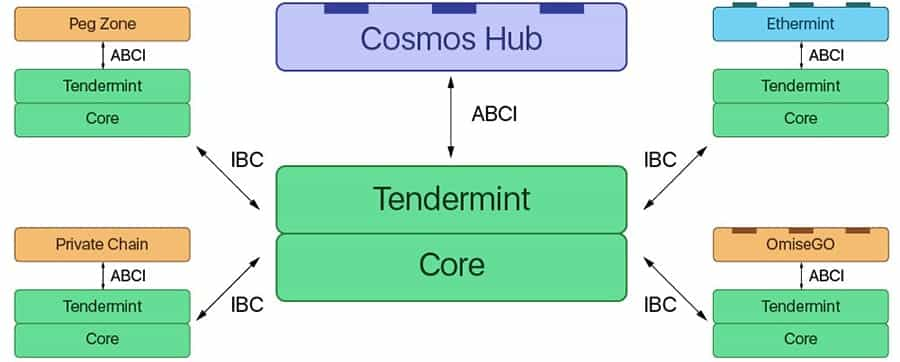
IBC will work best with blockchains that have high finality, such as Proof-of-Stake blockchains, but can also work with Proof-of-Work blockchains through the use of peg zones. An example is Ethermint, a Tendermint-based Ethereum with its PoW features stripped out and working on top of PoS consensus.
Explaining the Tendermint Algorithm
Tendermint is a Proof-of-Stake consensus algorithm created using the Practical Byzantine Fault Tolerant (PBFT) algorithm first proposed in 1999 by Castro and Liskov after 30 years of research. This BFT-based PoS protocol assigns the right to propose new blocks in a pseudo-random fashion to validators in a multi-round voting process.
Finalizing and committing those blocks requires a supermajority of validators signing off on the proposed block, however. In the case of Cosmos, this is two-thirds of the quorum. Reaching consensus in this fashion may take several rounds to finalize blocks. A BFT system can only tolerate up to one-third failures, with failures including malicious and arbitrary behaviors.

The Tendermint algorithm has the following features:
- A safety threshold of 1/3 of validators
- Compatible with public or private chains
- Consensus safety
- Prioritization of consistency
- Instant finality in under 3 seconds
Cosmos uses a Proof-of-Stake consensus known as delegated PoS. This organizes the stakers into groups of validators and groups of delegators. The delegators decide which validators will participate in consensus and the validators work to validate transactions and add new blocks to the blockchain.
Rewards are given to validators and delegators in the form of ATOM tokens, but the Cosmos Network is designed in such a way that a wrapped form of any cryptocurrency could theoretically be used as a reward token. In this system, any node found to be operating in a malicious fashion is removed from the network, and its tokens are taken away.
The ATOM Token
The Cosmos team held an ICO in April 2017, raising $17.3 million in just 28 minutes as they sold 168 million tokens at $0.098 each. The team also withheld 50 million tokens for themselves to fund strategic partnerships and business development.
The ATOM token was somewhat unique however as the actual tokens were not released until after the main net went live. There were some exchanges trading IOU tokens for ATOM prior to their release, but the actual token went live on March 14, 2019.
Two days later it reached a high of $8.31 but dropped from that level quickly. It jumped again to nearly $7 on April 22 when investors learned the token had been listed on the Binance Exchange.
Turning our attention to more recent price action, Atom hit its all-time high of $44.45 in September of 2021:
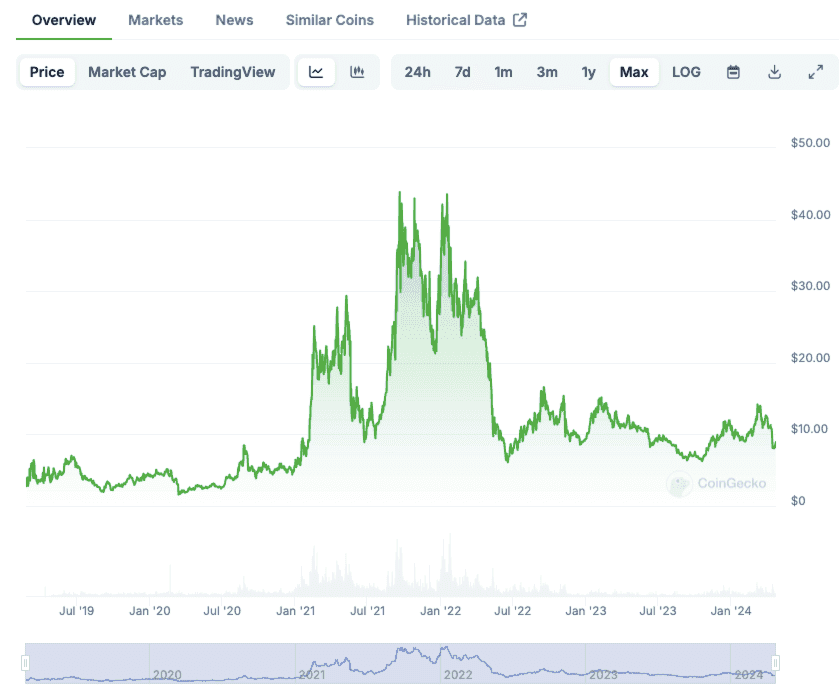
Along with the rest of the market, Atom crashed back down to a low of around $6.30 during the bear market and traded within a range for most of the 2022-2023 crypto winter. Atom has been showing signs of strength as we head further into 2024, though many alternative narratives and projects are outpacing it.
If you are interested in purchasing Atom, as it is one of the most popular cryptocurrencies in the top 50, it can be found on popular exchanges such as Bybit, Binance, OKX and Kraken.
If you plan on buying Cosmos, you will also need a wallet to store them. Feel free to check out our article on the Best Cosmos Wallets.
Atom 2.0
Cosmos initially envisioned creating a network of application-specific blockchains built with a common economic ethos and interoperable with the Inter-Blockchain Communication protocol. The zones were independent blockchain connected ideologically and economically with the Cosmos Hub.
In September 2022, the cryptosphere witnessed the release of the Atom 2.0 whitepaper, introducing new inter-chain collaboration capabilities that further exemplify Cosmos’s initial vision. This initiative was introduced to enhance the value of the Cosmos Hub, better serve its users, and strengthen its position within the broader blockchain ecosystem.
Key Aspects of the Ethos of Atom 2.0
Atom 2.0 is built around several core principles and goals that seek to redefine what the Cosmos Hub can achieve. Below are the primary aspects of its ethos and strategic vision:
- Increased Utility for ATOM: Atom 2.0 aims to transform the ATOM token from primarily a governance token to being a more utility-centric asset within the Cosmos network. This involves integrating new functionalities that will allow ATOM to be used in a variety of new ways, potentially including staking, fee payment, and as a medium of exchange in new interchain services.
- Enhanced Interchain Security: One of the key proposals under Atom 2.0 is the concept of Interchain Security. This feature allows the Cosmos Hub to secure other blockchains (referred to as consumer chains) by enabling them to use the security services of the Hub's validator set. This not only helps smaller chains gain robust security without extensive validator setups but also enhances the overall security ecosystem within the Cosmos network.
- Economic Sustainability: Atom 2.0 includes proposals for creating new economic models and revenue streams for the Cosmos Hub. These changes are designed to ensure the long-term sustainability of the hub and include mechanisms for capturing value from the services provided, such as transaction fees from Interchain Security.
- Hub Minimalism: The upgrade aims to position the Cosmos Hub as a lightweight provider of interchain services to the Cosmos ecosystem. It seeks to limit the capabilities of the hub and push application diversity to the Zones. Such minimalism is also seen in networks like Polkadot and Celstia that limit their main chain capabilities to security and interoperability.
Atom 2.0 represents a visionary leap forward for the Cosmos Hub, aiming to transform it into a more robust, secure, and versatile blockchain platform. Its ethos is centered around utility, security, sustainability, decentralized governance, scalability, and inclusivity. These enhancements are designed not just to benefit ATOM holders but to strengthen the entire Cosmos ecosystem, making it more competitive, innovative, and user-friendly.
Redefined Cosmos Architecture
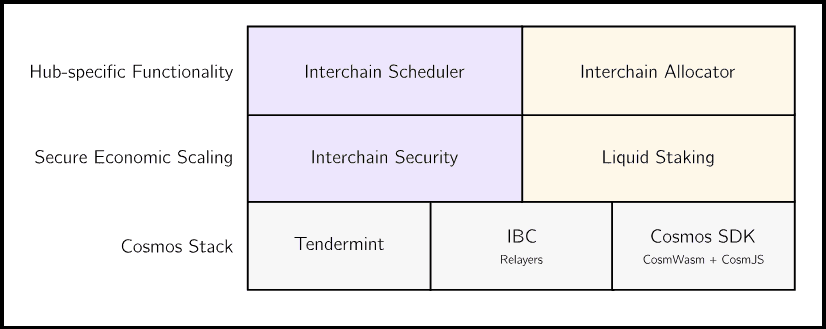
The Atom 2.0 upgrade adds two more layers above the initial Cosmos architecture. One layer is dedicated to introducing new economic scalability offerings to select Cosmos chains, while the top layer introduces new hub-specific functionality. Here’s a summary of the updated architecture:
- The Cosmos Stack: Includes the Tendermint Core, IBC and the Cosmos SDK. The stack enables application-specific network development in a variety of languages and execution environments, all interoperable with one another.
- Interchain Security: A mechanism that will allow certain Cosmos SDK chains to leverage Atom for crypto-economic security and also use the Cosmos Hub validators to bootstrap a new sovereign network in the Cosmos ecosystem.
- Liquid Staking: Atom 2.0 is introducing liquid staking to the Cosmos ecosystem to accrue more value from the ATOM token. It is akin to the liquid staking framework of Lido.
- Interchain Scheduler: An open and transparent MEV marketplace for cross-chain interaction within the Cosmos ecosystem. An official platform for MEV optimization eliminated manipulation and improves resource efficiency of Cosmos hub and zone interactions.
- Interchain Allocator: It is another strategic component designed to enhance resource distribution and utilization across various independent blockchains connected within the Cosmos network.
Interchain Security Overview
It is a mechanism that allows multiple Cosmos SDK blockchains (Zones) to share the validator set of the Cosmos Hub for security. This model is particularly beneficial for new chains without the resources or the community size to maintain robust security of their own.
How Does Interchain Security Work?
The process is boiled down to the following key components:
- Shared Validators:
- Cosmos Hub validators can opt to provide security to other chains via a governance proposal. This will entail them running additional nodes for the chains they provide security to, called consumer chains.
- These validators are staked on the Cosmos Hub with ATOM, and their performance and honesty are secured by their stake in the Hub. They will assume additional slashing conditions for the activity in the zones.
- Consumer Chains:
- They benefit from the high level of security without needing to establish and maintain their own independent set of validators.
- Consumer chains compensate the Cosmos Hub (and by extension, its validators) by providing a portion of their transaction fees or inflation rewards to the Hub, creating a symbiotic relationship.
- Security and Reliability:
- By leveraging the security of the Cosmos Hub, consumer chains can ensure a higher level of protection against attacks such as double-spending or chain reorganizations, which are more likely in chains with fewer validators.
- This system also allows for more reliable and consistent validation processes across different blockchains in the network.
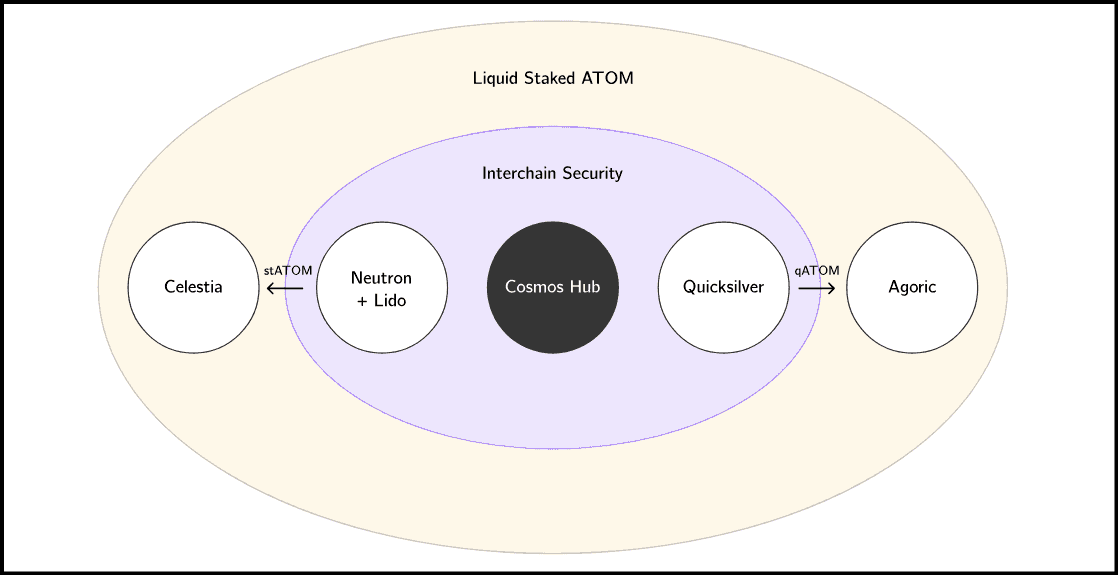
Benefits of Interchain Security
- Enhanced security for smaller chains.
- Increased utility for ATOM and its validators.
- Enhanced revenue for the Cosmos Hub.
- A more cohesive and stable ecosystem.
- Enhanced Decentralization.
Interchain Scheduler Overview
The Interchain Scheduler is designed to facilitate the execution of transactions that can be scheduled across multiple blockchains within the Cosmos network. This is particularly important for applications requiring coordinated actions across different chains, which is a common scenario in decentralized finance (DeFi) and other multi-chain operations.
How the Interchain Scheduler Works
- Scheduling Transactions:
- The primary function of the Interchain Scheduler is to allow developers and users to schedule transactions to occur at specific times or under specific conditions across different blockchains (zones) in the Cosmos network.
- This could involve, for example, the scheduled release of funds, automated balance adjustments between different entities, or the execution of specific smart contracts at predetermined times.
- Cross-Chain Coordination:
- By facilitating scheduled transactions, the Interchain Scheduler helps to synchronize and coordinate activities across various independent blockchains. This is crucial for maintaining consistency and reliability in operations that depend on the timing of transactions.
- It utilizes the Inter-Blockchain Communication (IBC) protocol to manage communication and execution between the chains, ensuring that actions are taken in a timely and secure manner.
- Use Cases:
- DeFi Applications: Automated swapping, liquidity management, and other financial operations that need to occur regularly without manual intervention.
- Cross-Chain Games and Applications: Events or actions in games or apps that need to happen at the same time across different ecosystems.
- Automated Governance Actions: Decentralized autonomous organizations (DAOs) can automate governance decisions or actions that need to be implemented across multiple platforms.
- Technical Implementation:
- The Scheduler works by embedding into the Cosmos SDK as a module that can be added to any blockchain built using the SDK. It leverages existing infrastructure such as IBC for inter-chain communication and adds the ability to plan and execute based on temporal parameters.
Interchain Allocator Overview
The Interchain Allocator in the Cosmos ecosystem is another strategic component designed to enhance resource distribution and utilization across various independent blockchains connected within the Cosmos network. This tool focuses on optimizing and governing the allocation of resources like tokens and other assets across different blockchains (often referred to as "zones") that form part of the Cosmos ecosystem.
Interchain Allocator Purpose and Functionality
- Resource Management: The core functionality of the Interchain Allocator revolves around the effective management of resources such as tokens, ensuring that they are distributed according to predefined policies and needs across the network. This helps in maintaining a balanced economic environment where resources are available where needed without central control.
- Decentralized Governance: It operates under the guidance of decentralized governance protocols, which means that the policies for resource allocation are determined by the community or stakeholders through a democratic process. This can include staking decisions, funding for public goods, or supporting specific projects within the Cosmos ecosystem.
- Use of Inter-Blockchain Communication (IBC): Similar to other Cosmos network components, the Allocator makes extensive use of the IBC protocol to transfer resources safely and efficiently between different chains. This is crucial for maintaining the integrity and security of transactions across the network's decentralized architecture.
- Economic Synchronization: By distributing resources where they are most needed, the Allocator helps in synchronizing the economic activities across different blockchains, promoting a more integrated and stable ecosystem. This is especially important for supporting new and smaller chains that might need more resources to develop their infrastructure and community.
Benefits of the Interchain Allocator
- Fair Resource Distribution: Ensures that resources are spread out equitably across the network, preventing resource hoarding and promoting a balanced development of all chains involved.
- Support for Growth: Provides necessary resources to newer and developing chains, helping them grow and become sustainable parts of the Cosmos ecosystem.
- Decentralized Control: Keeps the process of resource allocation decentralized and democratic, aligning with the ethos of the Cosmos network.
Redefined ATOM Issuance Rules
The redesign of $ATOM in Atom 2.0 is driven by a desire to enhance its utility and integration within the Cosmos ecosystem, especially in light of new functionalities such as liquid staking and interchain security.
These changes aim to align the token’s economic model more closely with the evolving landscape of blockchain technologies and cross-chain interactions. The introduction of a new issuance scheme seeks to adapt the economic environment of $ATOM to these new roles, supporting broader application scenarios while managing inflation and promoting network security. This approach is designed to ensure that the Cosmos Hub can continue to thrive as a central node in an increasingly interconnected blockchain space, balancing liquidity, capital growth, and stability.
Technical Details of Atom 2.0 Changes:
- Issuance Redesign in Two Phases:
- Transition Phase (36 months): Starts with an issuance of 10 million $ATOMs per month, reducing at a diminishing rate to stabilize at 300,000 $ATOMs per month by the end of the phase. This phase helps consumer chains integrate with Interchain Security and builds the Cosmos treasury for future development.
- Steady State Phase: Post-transition, a fixed monthly issuance of 300,000 $ATOMs continues indefinitely, promoting sustainable economic conditions and network growth.
- Economic and Security Adjustments:
- Initial heavy issuance transitions to a lower, stable rate, aiming to significantly reduce overall inflation to as low as 0.1% in the long term. This controlled inflation path intends to support both network security and token liquidity effectively.
- A security mechanism suspends the new issuance policy if the staking rate falls below 66%, reverting to the previous program to maintain network integrity.
- Token Allocation and Validator Incentives:
- The new issuance policy reallocates ATOMs primarily towards node rewards and the community pool, with a significant portion directed to the Cosmos treasury. The treasury's allocation is tightly regulated, with no more than 10% available per 21-day cycle during the transition phase.
- Validator revenues are adjusted to phase out direct subsidies over 36 months, compensated by expected increases in fee revenues from Interchain Security and cross-chain transactions facilitated by IBC. This gradual shift aims to sustain validator engagement by replacing subsidies with potentially higher earnings from transaction fees.
These structured changes in Atom 2.0 are designed to enhance the economic foundations of the Cosmos Hub while fostering greater integration and security across its connected blockchain ecosystem. The overall goal is to create a robust, sustainable economic model that can adapt to future challenges and opportunities in the interchain landscape.
Atom 2.0 Conclusion
Atom 2.0 represents a visionary leap forward for the Cosmos Hub, aiming to transform it into a more robust, secure, and versatile blockchain platform. Its ethos is centered around utility, security, sustainability, decentralized governance, scalability, and inclusivity. These enhancements are designed not just to benefit ATOM holders but to strengthen the entire Cosmos ecosystem, making it more competitive, innovative, and user-friendly. Through Atom 2.0, the Cosmos Hub hopes to set a new standard for what a blockchain hub can achieve, emphasizing its role as a central pillar in the interchain future.
Proposal 848
In November 2023, a proposal was approved that sought to reduce the maximum ATOM inflation rate to 10% from about 14%, lowering staking APR to 13.4% from 19%.
This will be the first of three proposals being voted on to reduce inflation, provide better incentives for staking, and improve the security of the network.
The proposal passed with 41.1% of votes in favour versus 38.5% of votes against. Initially projected to fail, a late surge of votes and some validator reversals tipped the outcome in favour, The Block reported.
Cosmos Team
There is a huge push behind the Cosmos project, including a number of companies, teams, and foundations. The idea for Cosmos came from Jae Kwon and Ethen Buchman, but the main support for Cosmos comes from the Swiss non-profit foundation The Interchain Foundation (ICF).
ICF has contracted with All in Bits Inc. (dba Tendermint Inc.) to develop the Cosmos Network and the ecosystem that surrounds it. That ecosystem is extremely broad as you’ll see later.
The connection is made slightly clearer given that Jae and Ethan are the founders of Tendermint. The broader Tendermint team is indeed quite large with over 30 members.
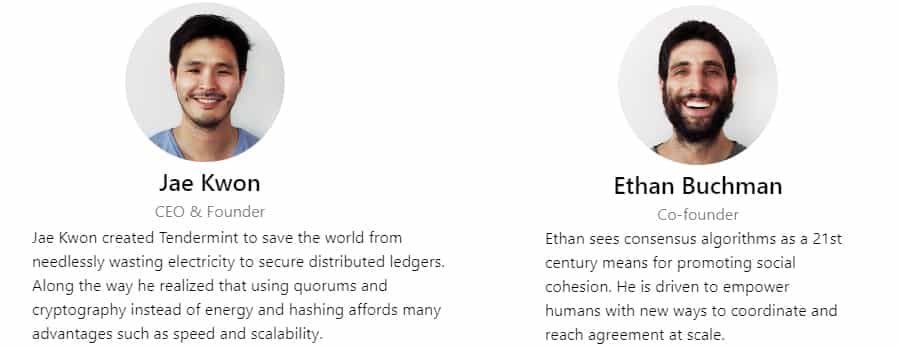
Finally, there is the IRIS Foundation, which has found support from ICF to create the Cosmos Hub IRISnet, which is meant to facilitate the construction of distributed business applications. All of these entities work together very closely, and it can be difficult to distinguish between the different organizations and how they contribute to the development of Cosmos.
The team is also quite active when it comes to community engagement. They run an active official blog where they detail all of the important development updates. They also have a Twitter account and Telegram Channel. I took a dive into their 10,000-member-strong Telegram channel the conversation was quite encouraging with more tech-focused participants.
Cosmos Hub 3
After the March 2019 launch of the mainnet for Cosmos, and prior to the February 2021 launch of IBC, the only other major update from the project came in December 2019, when they launched Cosmos 3. This update was primarily focused on improving the governance mechanism at Cosmos.
One of the most important changes made by Cosmos 3 is that governance proposals are no longer just a signaling mechanism. Before Cosmos 3 any proposed changes that were passed by the community needed to be enacted by developers and released as new software that was then run by participating validators. This is also known as a hard fork.
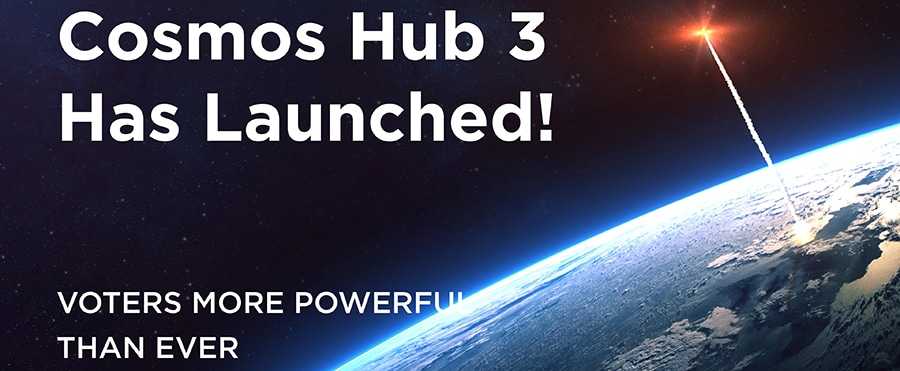
With Cosmos Hub 3 voters are now able to change how Cosmos works at a fundamental level, and those changes can be implemented without the need for a hard fork. Some of the changes that can be made include increasing or decreasing the inflation rate, changing the minimum threshold at which staking influences inflation, the community tax rate, and many more.
The upgrade to Cosmos Hub 3 has also made it possible for proposals to spend government pool funds, which are currently nearly 250,000 ATOM worth over $1 million.
The upgrade to Cosmos Hub 3 has also eventually made it possible for the community to vote for the launch of IBC and for the creation of Gravity DEX.
Gravity DEX
Cosmos is entering the DeFi space by creating the Gravity DEX, which will serve as an Automated Market Maker (AMM) with decentralized liquidity providing and coin swap functions.
The module enables users to create a liquidity pool, make deposits and withdrawals, and request coin swaps from the liquidity pool.
Gravity DEX enables decentralized trading between any two Cosmos tokens — a $90 billion market that includes ATOM, BNB, LUNA, and CRO — or any of the galaxy of tokens beyond the Cosmos ecosystem.
Gravity uses the Inter-Blockchain Communication (IBC) protocol to enable swaps and pools of digital assets between any two blockchains within the Cosmos ecosystem or beyond. Gravity also achieves superior efficiency compared to other AMMs due to its groundbreaking Equivalent Swap Price Model.
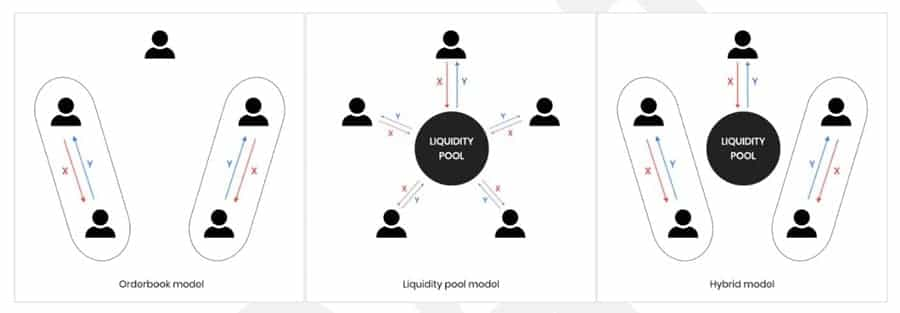
The Cosmos Hub AMM should have a strong philosophy of inclusiveness of users from different blockchains because its prime utility is inter-blockchain communication.
To possess such characteristics, the liquidity module should provide the most convenient ways for external users to come in and use the services provided by the Cosmos Hub.
The liquidity module should not anticipate specific assets, such as Atom, into the process of user flow in a forced manner. It is repeatedly proved that unnatural anticipation of native coin at unavoidable parts of the process results in poor user attraction.
The Cosmos Ecosystem
Cosmos has had no problems attracting partners to its ecosystem. There’s a huge number of projects already developing on top of the Cosmos technology and part of its ecosystem. Here’s just a small group of them:
- The Binance Chain, which is the token-emitting platform of the decentralized Binance Launchpad project, is built on the Cosmos ecosystem. They use a forked version of Tendermint and the Cosmos SDK, as well as Cosmos SDK features such as "bank" which is used for basic token transactions.
- Akash is working to bring serverless computing to Cosmos, functioning as a peer-to-peer supercloud for serverless computing that will provide developers with an open, secure, permissionless marketplace for unused compute cycles. They expect to reduce the cost of cloud computing resources by 90% in comparison with services such as Microsoft Azure, AWS, and Google Cloud.
- e-Money is a European stablecoin issuer. Their stablecoins are backed by fiat currency and are unique in that they bear interest and are protected by an insolvency fund.
- IOV is creating a protocol between blockchains and wallets that will make it possible to send and receive any cryptocurrency at all from a single address of value.
- IRISnet is a BPoS blockchain that was built using the Cosmos SDK and will allow interoperability between blockchains to provide a foundation for the next generation of distributed business applications. It launched its mainnet in September 2019.
- Kava is working with the Cosmos network to provide wallets, exchanges and blockchains with the liquidity and interoperability of Interledger technology. More recently they launched their mainnet in November 2019, and the project is now at the forefront of the blooming DeFi ecosystem.
- Loom began on the Ethereum blockchain and later switched to Cosmos to take advantage of the Tendermint technology in its development of highly scalable-games and user-facing dApps. More recently it has been branching out to tackle DeFi, and usage by governments and ecterprises.
- Decentralized exchange dYdX said it would move away from Ethereum and develop its own blockchain on Cosmos.
Other projects are aimed at tokenizing the music industry (Playlist), creating a truly decentralized peer-to-peer network (Sentinel Network), creating a decentralized autonomous content economy (Lino), building a social network to determine when information is true or not (TruStory), and launching a stablecoin meant for mass adoption (Terra).
There’s a more complete list of nearly 100 projects looking to build on top of the Cosmos Network and Tendermint technology if you want to check it out.
Development & Roadmap
Of course, with most of these blockchain projects, the proof is in the pudding. In order to get a sense of just how much work is being done, we need to take a look at the project code commits.
One of the best ways to get a sense of this activity is through the project's commit activity on their public GitHub. In the case of Cosmos, you have a number of different GitHub repos both from the main project to the Tendermint repositories.
I decided to take a sneak peak into these to see the amount of activity that is present. Below are just some of the most active repos in the ecosystem.
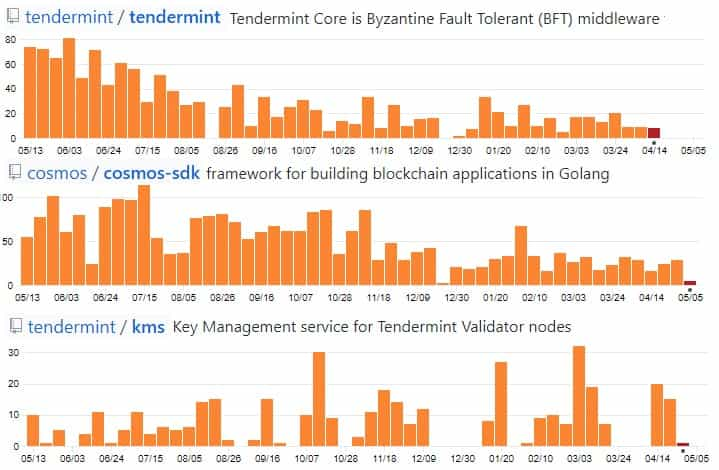
I have not seen this level of development on many other projects (including those with larger ICOs). This should further reinforce the notion that this is anything but a run-of-the-mill ICO and blockchain project.
This voluminous and frenetic coding activity is most likely related to their ambitious roadmap. Over the past year the team has been meeting a number of important milestones almost to a tee.
There are also quite a few upgrade proposals that are lying ahead for the project. These include Hub Support for the IBC protocol which will allow some of the SDK applications to connect to the Hub. You can see the roadmap here.
Conclusion
The introduction of the Cosmos mainnet sparked considerable enthusiasm within the blockchain community, as evidenced by the initial surge in the price of the ATOM token and its swift listing on Binance among other major exchanges. The token's early climb to the #15 spot in total market cap underscored the project's significance and potential for investment.
Despite a period of fewer updates following the mainnet launch, ATOM has maintained a strong presence in the crypto world, consistently ranking within the top tokens by market cap. This resilience highlights the community's sustained confidence in the vision and future of Cosmos.
The implementation of the Inter-Blockchain Communication (IBC) protocol marked a crucial phase in Cosmos' evolution, enhancing its infrastructure to allow for seamless interactions between different blockchains. This development was a significant step towards realizing the project’s ambition to become the "internet of blockchains," which would solidify its vital role in the broader blockchain ecosystem.
The recent advancements under Atom 2.0 have introduced profound changes aimed at further optimizing the network's economic model and expanding its functionalities. These include a new token issuance scheme designed to better support the network’s security and development needs, and the pioneering Interchain Security feature, which enables the Cosmos Hub to provide security services to other blockchains in the network. This not only improves security across the board but also creates additional value and utility for the ATOM token.
Looking forward, the Cosmos team remains committed to broadening its technological capabilities with ongoing projects such as the decentralized Gravity DEX, bridges to Ethereum and Bitcoin, and other cross-chain initiatives that leverage the robust capabilities of IBC.
The persistent dedication of the Tendermint and Cosmos developers, combined with the robust ecosystem of partner projects utilizing the network, are clear indicators of the project's substantial progress and alignment with its original goals. With these continual developments and the community's vibrant support, Cosmos is well-positioned to maintain its influential status in the blockchain world for the foreseeable future.
Frequently Asked Questions
Atom 2.0 is a comprehensive update to the Cosmos Hub that aims to revamp the network’s economic model and enhance the overall functionality of the ATOM token. It introduces significant changes such as a new token issuance scheme and the implementation of Interchain Security, which allows the Cosmos Hub to offer security services to other blockchains. This update is designed to increase the utility, security, and economic sustainability of the Cosmos ecosystem, ensuring it remains a key player in the broader blockchain landscape.
The ATOM token serves several key functions within the Cosmos network:
- Governance: ATOM holders can vote on proposals to change network parameters or upgrade the system, influencing the future direction of the Cosmos Hub.
- Staking: Tokens can be staked to support network security. Stakers earn rewards and help secure the network by participating in consensus through validators.
- Interchain Security: With the advent of Atom 2.0, ATOM can also be used to secure other blockchains in the Cosmos network, further expanding its use cases.
- Fee Payment: ATOM is used to pay for transaction fees within the Cosmos Hub, facilitating operations and interactions on the network.
Recent developments in Cosmos focus on enhancing interoperability and usability across the network:
- Interchain Security: This new feature allows the Cosmos Hub to secure other chains, enhancing network cohesion and security.
- Atom 2.0: A major update that includes changes to the token economics and additional functionalities for the ATOM token.
- Gravity DEX and Bridges: The ongoing development of decentralized exchanges like the Gravity DEX and bridges to other major blockchains (such as Ethereum and Bitcoin) to facilitate easier asset transfer and expand market access.
- Increased IBC Capabilities: Improvements to the Inter-Blockchain Communication protocol to support more complex transactions and interactions between different blockchains in the network.
No, Cosmos zones are not layer 2 chains. Instead, they are independent blockchains that operate alongside the Cosmos Hub and can have their own validators, governance structures, and economic models. Each zone in the Cosmos network uses the Inter-Blockchain Communication (IBC) protocol to interact seamlessly with other zones and the Hub, maintaining autonomy while benefiting from the security and interoperability features of the Cosmos ecosystem. This structure differs from layer 2 solutions, which are built on top of and secured by a primary (layer 1) blockchain without the same level of independence exhibited by Cosmos zones.
Disclaimer: These are the writer’s opinions and should not be considered investment advice. Readers should do their own research.


